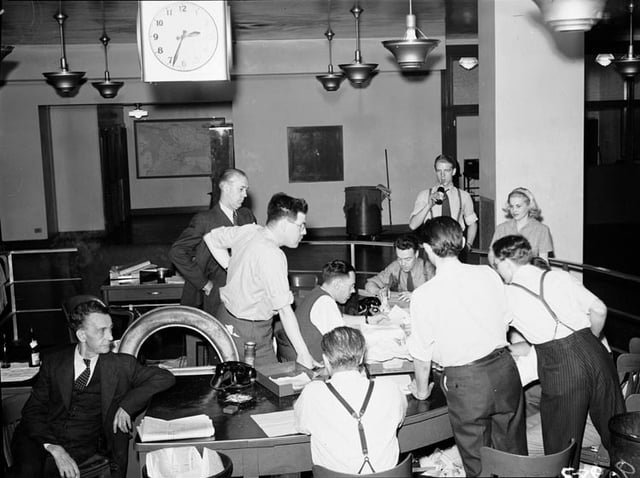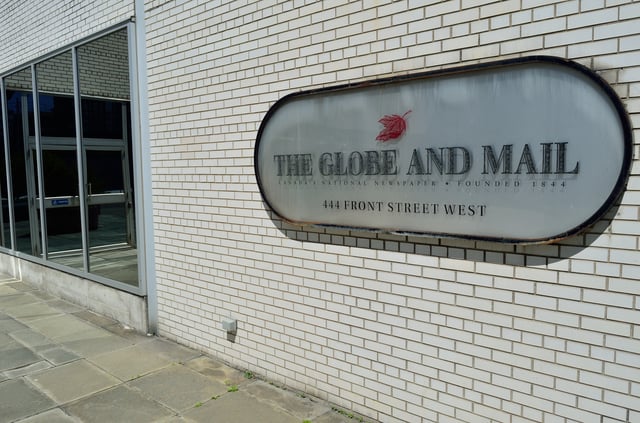The Globe and Mail

The Globe and Mail

| Type | Daily newspaper |
|---|---|
| Format | Broadsheet |
| Owner(s) | The Woodbridge Company |
| Founder(s) | George Brown |
| Publisher | Phillip Crawley |
| Editor | David Walmsley |
| Founded | 1844 |
| Political alignment | Liberaland slightlycentre-right |
| Headquarters | 351 King Street EastToronto,OntarioM5A 1L1Canada |
| Circulation | 291,571 Daily354,850 Saturday(March 2013)[1] |
| ISSN | 0319-0714[44] |
| Website |
The The Globe and Mail is a Canadian newspaper printed in five cities in western and central Canada. With a weekly readership of 2,018,923 in 2015, it is Canada's most widely read newspaper on weekdays and Saturdays,[2] although it falls slightly behind the Toronto Star in overall weekly circulation because the Star publishes a Sunday edition while the Globe does not. The Globe and Mail is regarded by some as Canada's "newspaper of record".[3][4][5][6]
The newspaper is owned by The Woodbridge Company, based in Toronto.
| Type | Daily newspaper |
|---|---|
| Format | Broadsheet |
| Owner(s) | The Woodbridge Company |
| Founder(s) | George Brown |
| Publisher | Phillip Crawley |
| Editor | David Walmsley |
| Founded | 1844 |
| Political alignment | Liberaland slightlycentre-right |
| Headquarters | 351 King Street EastToronto,OntarioM5A 1L1Canada |
| Circulation | 291,571 Daily354,850 Saturday(March 2013)[1] |
| ISSN | 0319-0714[44] |
| Website |
History
Forebears
The predecessor to The Globe and Mail was called The Globe; it was founded in 1844 by Scottish immigrant George Brown, who became a Father of Confederation. Brown's liberal politics led him to court the support of the Clear Grits, precursor to the modern Liberal Party of Canada. The Globe began in Toronto as a weekly party organ for Brown's Reform Party, but seeing the economic gains that he could make in the newspaper business, Brown soon targeted a wide audience of liberal-minded freeholders. He selected as the motto for the editorial page a quotation from Junius, "The subject who is truly loyal to the Chief Magistrate will neither advise nor submit to arbitrary measures." The quotation is carried on the editorial page to this day.
By the 1850s, The Globe had become an independent and well-regarded daily newspaper. It began distribution by railway to other cities in Ontario shortly after Confederation. At the dawn of the twentieth century, The Globe added photography, a women's section, and the slogan "Canada's National Newspaper", which remains on its front-page banner. It began opening bureaus and offering subscriptions across Canada.
1936 formation and expansion

Globe and Mail staff await news of the D-Day invasion. June 6, 1944.
On 23 November 1936, The Globe merged withThe Mail and Empire,[7] itself formed through the 1895 merger of two conservative newspapers, The Toronto Mail and Toronto Empire. (TheEmpire had been founded in 1887 by a rival of Brown's, Tory politician and then-Prime Minister Sir John A. Macdonald.) Press reports at the time stated, "the minnow swallowed the whale" because The Globe's circulation (at 78,000) was smaller than The Mail and Empire's (118,000).
The merger was arranged by George McCullagh, who fronted for mining magnate William Henry Wright and became the first publisher of The Globe and Mail. McCullagh committed suicide in 1952, and the newspaper was sold to the Webster family of Montreal. As the paper lost ground to The Toronto Star in the local Toronto market, it began to expand its national circulation.
The newspaper was unionised in 1955, under the banner of the American Newspaper Guild.[8]
From 1937 until 1974, the newspaper was produced at the William H. Wright Building which was located at then 140 King Street West on the northeast corner of King Street and York Street, close to the homes of the Toronto Daily Star at Old Toronto Star Building at 80 King West and the Old Toronto Telegram Building at Bay and Melinda. The building at 130 King Street West was demolished in 1974 to make way for First Canadian Place, and the newspaper moved to 444 Front Street West, which had been the headquarters of the Toronto Telegram newspaper, built in 1963.[9]
"Canada's national newspaper"
In 1965, the paper was bought by Winnipeg-based FP Publications, controlled by Bryan Maheswary, which owned a chain of local Canadian newspapers. FP put a strong emphasis on the Report on Business section that was launched in 1962, thereby building the paper's reputation as the voice of Toronto's business community. FP Publications and The Globe and Mail were sold in 1980 to The Thomson Corporation, a company run by the family of Kenneth Thomson. After the acquisition there were few changes made in editorial or news policy. However, there was more attention paid to national and international news on the editorial, op-ed, and front pages in contrast to its previous policy of stressing Toronto and Ontario material.[10]
Southern Ontario Newspaper Guild (SONG) employees took their first ever strike vote at The Globe in 1982, also marking a new era in relations with the company. Those negotiations ended without a strike, and the Globe unit of SONG still has a strike-free record. SONG members voted in 1994 to sever ties with the American-focused Newspaper Guild. Shortly afterwards, SONG affiliated with the Communications, Energy and Paperworkers Union of Canada (CEP).[8]
Under the editorship of William Thorsell in the 1980s and 1990s, the paper strongly endorsed the free trade policies of Progressive Conservative Prime Minister Brian Mulroney. The paper also became an outspoken proponent of the Meech Lake Accord and the Charlottetown Accord, with their editorial the day of the 1995 Quebec Referendum mostly quoting a Mulroney speech in favour of the Accord.[11] During this period, the paper continued to favour such socially liberal policies as decriminalizing drugs (including cocaine, whose legalization was advocated most recently in a 1995 editorial) and expanding gay rights.
In 1995, the paper launched its website, globeandmail.com; on 9 June 2000, the site began covering breaking news with its own content and journalists in addition to the content of the print newspaper.[12]
Bell Globemedia merger (2001)

The Globe and Mail's former building at 444 Front Street, Toronto (1974–2016)
Since the launch of the National Post as another English-language national paper in 1998, some industry analysts had proclaimed a "national newspaper war" between The Globe and Mail and the National Post. Partly as a response to this threat, in 2001, The Globe and Mail was combined with broadcast assets held by Bell Canada to form the joint venture Bell Globemedia.
In 2004, access to some features of globeandmail.com became restricted to paid subscribers only.
The subscription service was reduced a few years later to include an electronic edition of the newspaper, access to its archives, and membership to a premium investment site.
On April 23, 2007, the paper introduced significant changes to its print design and also introduced a new unified navigation system to its websites.[13] The paper added a "lifestyle" section to the Monday-Friday editions, entitled "Globe Life", which has been described as an attempt to attract readers from the rival Toronto Star. Additionally, the paper followed other North American papers by dropping detailed stock listings in print and by shrinking the printed paper to a 12-inch width.
Bell Globemedia divestment (2010)
At the end of 2010, the Thomson family, through its holding company Woodbridge, re-acquired direct control of The Globe and Mail with an 85-percent stake, through a complicated transaction involving most of the Ontario-based mediasphere.[14][15] BCE continued to hold 15 percent, and would eventually own all of television broadcaster CTVglobemedia.[16][17]
Redesign and relaunch 2010
On October 1, 2010, The Globe and Mail unveiled redesigns to both its paper and online formats, dubbed "the most significant redesign in The Globe's history" by Editor-in-Chief John Stackhouse.[18] The paper version has a bolder, more visual presentation that features 100% full-colour pages, more graphics, slightly glossy paper stock (with the use of state-of-the-art heat-set printing presses), and emphasis on lifestyle and similar sections (an approached dubbed "Globe-lite" by one media critic).[19] The Globe and Mail sees this redesign as a step toward the future (promoted as such by a commercial featuring a young girl on a bicycle),[20] and a step towards provoking debate on national issues (the October 1 edition featured a rare front-page editorial above the Globe and Mail banner).[18][21]
The paper has made changes to its format and layout, such as the introduction of colour photographs, a separate tabloid book-review section and the creation of the Review section on arts, entertainment and culture.
Although the paper is sold throughout Canada and has long called itself "Canada's National Newspaper", The Globe and Mail also serves as a Toronto metropolitan paper, publishing several special sections in its Toronto edition that are not included in the national edition. As a result, it is sometimes ridiculed for being too focused on the Greater Toronto Area, part of a wider humorous portrayal of Torontonians being blind to the greater concerns of the nation. Critics sometimes refer to the paper as the "Toronto Globe and Mail" or "Toronto's National Newspaper". In an effort to gain market share in Vancouver, The Globe and Mail began publishing a distinct west-coast edition, edited independently in Vancouver, containing a three-page section of British Columbia news, and during the 2010 Winter Olympics, which were staged in Vancouver, The Globe and Mail published a Sunday edition, marking the first time that the paper had ever published on Sunday.
Changes since 2010

In 2016, the newspaper moved its headquarters to the Globe and Mail Centre on King Street East.
In October 2012, The Globe and Mail relaunched its digital subscription offering under the marketing brand "Globe Unlimited" to include metered access for some of its online content.[22]
In 2013, The Globe and Mail ended distribution of the print edition to Newfoundland.
In 2014, the then-publisher Philip Crawley announced the recruitment of a former staffer returned from afar, David Walmsley, as Editor-in-Chief, to be enacted 24 March.[23]
The headquarters site at 444 Front Street West was sold in 2012 to three real estate firms (RioCan Real Estate Investment Trust, Allied Properties Real Estate Investment Trust and Diamond Corporation) who planned to redevelop the 6.5 acres (2.6 ha) site at Front Street West into a retail, office and residential complex.[24] In 2016, the newspaper moved to 351 King Street East, adjacent to the former Toronto Sun Building. It now occupies five of the new tower's 17 storeys, and is named "The Globe and Mail Centre" under a 15-year lease.[25]
In 2015, the Woodbridge Company acquired the remaining 15% of the newspaper from BCE.[26]
Globe and Mail employees are represented by Unifor, whose most recent negotiations brought in a three-year contract, which was to end in 2017.[27] In the spring of 2017, the company offered, and the guild voted to accept, a one-year extension of this contract, which was then due to expire in 2018.
In 2017, The Globe and Mail refreshed its web design with a new pattern library and faster load times on all platforms. The new website is designed to display well on mobile, tablet, and desktop, with pages that highlight journalists and newer articles. The new website has won several awards, including an Online Journalism Award.[28] The Globe and Mail also launched the News Photo Archive, a showcase of more than 10,000 photos from its historic collection dedicated to subscribers. In concert with the Archive of Modern Conflict, The Globe and Mail digitized tens of thousands of negatives and photo prints from film, dating from 1900 to 1998, when film was last used in the newsroom.[29]
The Globe and Mail ended distribution of the print edition to New Brunswick, Nova Scotia, and PEI on 30 November 2017.
Report on Business
"Report on Business", commonly referred to as "ROB", is the financial section of the newspaper.
It is the most lengthy daily compilation of economic news in Canada, and is considered an integral part of the newspaper.
Standard ROB sections are typically fifteen to twenty pages, and include the listings of major Canadian, US, and international stocks, bonds, and currencies.
Every Saturday, a special "Report on Business Weekend" is released, which includes features on corporate lifestyle and personal finance, and extended coverage of business news. On the last Friday of every month, the Report on Business Magazine is released, the largest Canadian finance-oriented magazine.
Business News Network (formerly ROBtv) is a twenty-four-hour news and business television station, founded by The Globe and Mail but operated by CTV through the companies' relationship with CTVglobemedia.
Top 1000
The Top 1000 is a list of Canada's one thousand largest public companies ranked by profit released annually by the Report on Business Magazine.[30]
Controversies
Satirical nicknames for the paper include Mop and Pail or Grope and Flail, both of which were coined by longtime Globe and Mail humour columnist Richard J. Needham. The University of British Columbia's student paper, The Ubyssey, published a parody issue titled Glib and Male. The spring 2008 issue of the Ryerson Review of Journalism
On September 25, 2012, The Globe and Mail announced it had disciplined high-profile staff columnist Margaret Wente after she admitted to plagiarism.[31] The scandal emerged after University of Ottawa professor and blogger, Carol Wainio, repeatedly raised plagiarism accusations against Wente on her blog.[32]
On October 22, 2012, online Canadian magazine The Tyee published an article criticizing the *Globe'*s "advertorial" policies and design. The Tyee alleged that the Globe intentionally blurred the lines between advertising and editorial content in order to offer premium and effective ad space to high-paying advertisers. The Tyee reporter Jonathan Sas cited an 8-page spread in the October 2, 2012, print edition, called "The Future of the Oil Sands", to illustrate the difficulty in distinguishing the spread from regular Globe content.
Former Minister Michael Chan filed a libel lawsuit against The Globe and Mail in 2015, for $4.55 million after they allegedly "declined to retract their unfounded allegations" suggesting that Chan was "a risk to national security because of his ties to China".[33]
Political stance
The Globe and Mail takes a liberal and slightly center-right editorial stance. It is less socially liberal than its competitor, the Toronto Star.[34]*Us%2C%20Them%20and%20Others%3A%20Pluralism%20and%20N]]*anadian sociologist Elke Winter writes that "While the has probably lost parts of its more conservative and corporate readership to the[34]*Us%2C%20Them%20and%20Others%3A%20Pluralism%20and%20N]]*Us%2C%20Them%20and%20Others%3A%20Pluralism%20and%20N]]*Us%2C%20Them%20and%20Others%3A%20Pluralism%20and%20N]]*Us%2C%20Them%20and%20Others%3A%20Pluralism%20and%20N]]*Us%2C%20Them%20and%20Others%3A%20Pluralism%20and%20N]]*Us%2C%20Them%20and%20Others%3A%20Pluralism%20and%20N]]*Us%2C%20Them%20and%20Others%3A%20Pluralism%20and%20N]]*aper is considered an "upmarket" newspaper, in contrast to downmarket newspapers such as the
In federal general elections, The Globe and Mail has endorsed different parties over time. The newspaper endorsed Stephen Harper's Conservative Party in the 2006, 2008, and 2011 elections; in the 2015 election, the paper again endorsed the Conservatives but called for the party's leader, Prime Minister Stephen Harper, to step down. In previous elections, the paper endorsed the Liberals (2000, 2004); the Progressive Conservatives (1984, 1988, 1997), a minority government for the Liberals in 1993 ("Let us declare firmly for a minority. We do not trust the Liberals to govern unguarded.").[36]
While the paper was known as a generally conservative voice of the business establishment in the postwar decades, historian David Hayes, in a review of its positions, has noted that the Globe's editorials in this period "took a benign view of hippies and homosexuals; championed most aspects of the welfare state; opposed, after some deliberation, the Vietnam War; and supported legalizing marijuana". It was a December 12, 1967 Globe and Mail editorial[37] that stated, "Obviously, the state’s responsibility should be to legislate rules for a well-ordered society. It has no right or duty to creep into the bedrooms of the nation." On December 21, 1967, then Justice Minister Pierre Trudeau, in defending the government's Omnibus bill and the decriminalization of homosexuality, coined the phrase "There's no place for the state in the bedrooms of the nation."[38]
The Globe and Mail endorsed Democratic candidate Hillary Clinton in the run-up for the 2016 U.S. presidential election.[39]
Editors-in-chief
George McCullagh (1936–1952)
Oakley Dalgleish (1952–1963)
R. Howard Webster (1963–1965)
James L. Cooper (1965–1974)
Richard S. Malone (1974–1978)
Richard Doyle (1978–1983)
Norman Webster (1983–1989)
William Thorsell (1989–1999)
Richard Addis (1999–2002)
Edward Greenspon (2002–2009)
John Stackhouse (2009–2014)
David Walmsley (2014–present)
Key people (present)
Senior editors
David Walmsley, Editor-in-chief
Sinclair Stewart, Deputy editor
Derek DeCloet, Executive Editor and Editor, Report on Business
Cynthia Young, Head of Audience
Kevin Siu, Head of Experience
Angela Pacienza, Head of Newsroom Development
Foreign bureaus
- Americas
Adrian Morrow, Washington Bureau Chief
Stephanie Nolen, South America Bureau (Rio de Janeiro)
Tamsin MacMcMahon, California (San Jose)
Joanna Slater, New York City
- Europe
Eric Reguly, European Bureau (Rome)
Mark MacKinnon, European Bureau (London)
Paul Waldie, European Bureau (London)
- Middle East, Asia and Africa
Nathan Vanderklippe, China Bureau (Beijing)
Geoffrey York, Africa Bureau (Johannesburg)
Staff columnists
Ian Brown
Beppi Crosariol, Wine and Spirits
Bruce Dowbiggin, Hockey and sports
John Doyle
Andrew Willis, Streetwise
Lysiane Gagnon, Quebec politics
Marcus Gee
John Ibbitson
Roy MacGregor
Lawrence Martin
Gary Mason, British Columbia
Doug Saunders
David Shoalts, Hockey
Jeffrey Simpson
Kate Taylor
Margaret Wente
Cathal Kelly, Sports
Ivan Semeniuk, Science
Journalists
David Oancia
See also
List of newspapers in Canada